Analyzing Hospitality Distribution Channels for Revenue Growth
VerifiedAdded on 2022/01/17
|9
|4084
|134
Report
AI Summary
This report delves into the critical role of hospitality distribution channels in achieving higher occupancy rates and revenue for hotels. It begins by highlighting the shift from manual reservation systems to electronic channels, emphasizing the significance of reservation managers, revenue managers, and front office managers in this process. The report then explores the concept of distribution channels, differentiating between direct and indirect forms, and focuses on the various channels available for hotel room bookings, including hotel websites, direct calls, and third-party websites like OTAs. It categorizes and explains different types of distribution channels, such as Central Reservation Systems (CRS), including affiliate and non-affiliate networks, and Global Distribution Systems (GDS), detailing their operations and the key players like Amadeus, Galileo International, and Worldspan. The report further examines the functions of CRS and GDS, their operations, and their impact on the sales and distribution of hotel rooms, providing a comprehensive overview of the modern hospitality distribution landscape.
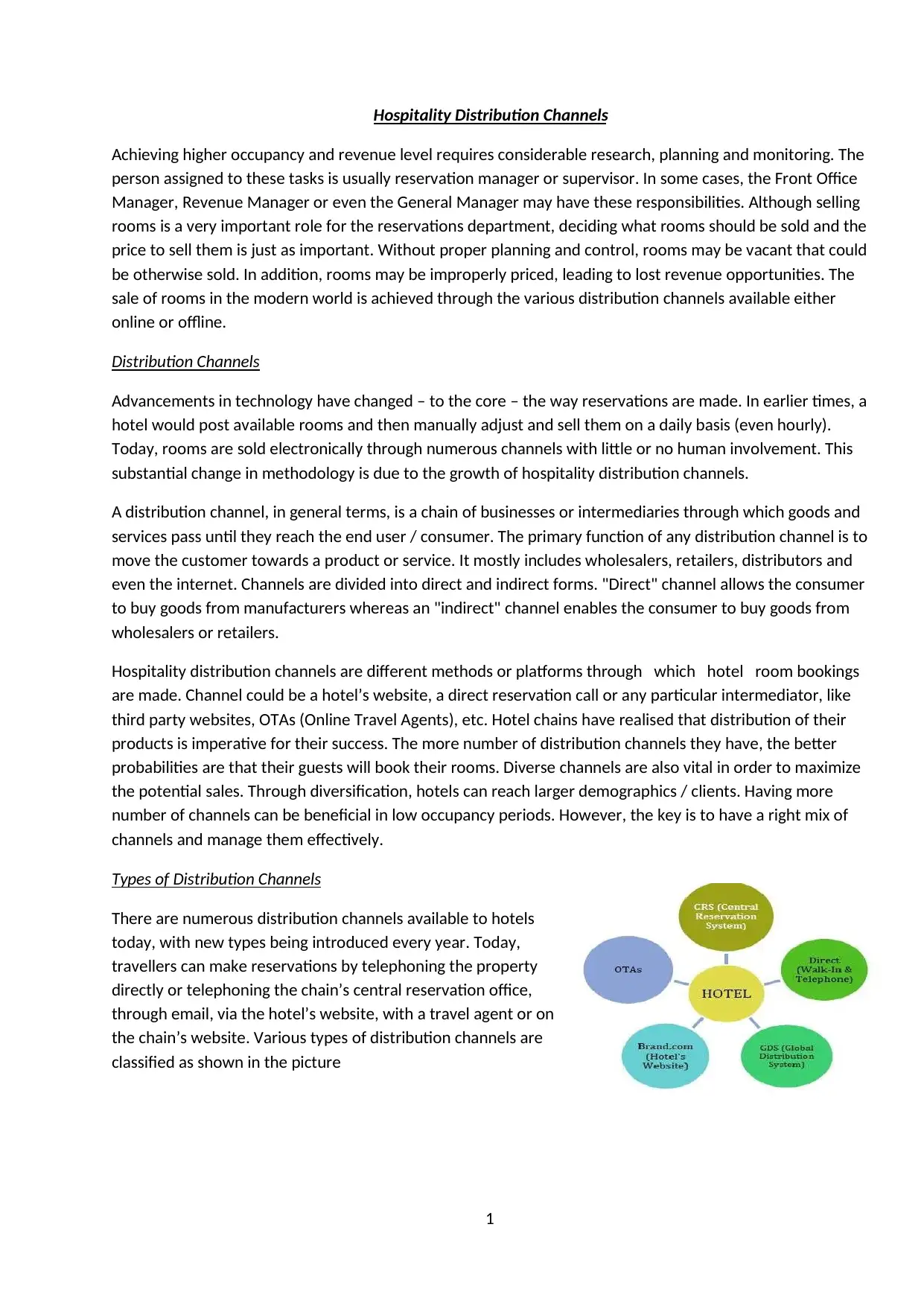
1
Hospitality Distribution Channels
Achieving higher occupancy and revenue level requires considerable research, planning and monitoring. The
person assigned to these tasks is usually reservation manager or supervisor. In some cases, the Front Office
Manager, Revenue Manager or even the General Manager may have these responsibilities. Although selling
rooms is a very important role for the reservations department, deciding what rooms should be sold and the
price to sell them is just as important. Without proper planning and control, rooms may be vacant that could
be otherwise sold. In addition, rooms may be improperly priced, leading to lost revenue opportunities. The
sale of rooms in the modern world is achieved through the various distribution channels available either
online or offline.
Distribution Channels
Advancements in technology have changed – to the core – the way reservations are made. In earlier times, a
hotel would post available rooms and then manually adjust and sell them on a daily basis (even hourly).
Today, rooms are sold electronically through numerous channels with little or no human involvement. This
substantial change in methodology is due to the growth of hospitality distribution channels.
A distribution channel, in general terms, is a chain of businesses or intermediaries through which goods and
services pass until they reach the end user / consumer. The primary function of any distribution channel is to
move the customer towards a product or service. It mostly includes wholesalers, retailers, distributors and
even the internet. Channels are divided into direct and indirect forms. "Direct" channel allows the consumer
to buy goods from manufacturers whereas an "indirect" channel enables the consumer to buy goods from
wholesalers or retailers.
Hospitality distribution channels are different methods or platforms through which hotel room bookings
are made. Channel could be a hotel’s website, a direct reservation call or any particular intermediator, like
third party websites, OTAs (Online Travel Agents), etc. Hotel chains have realised that distribution of their
products is imperative for their success. The more number of distribution channels they have, the better
probabilities are that their guests will book their rooms. Diverse channels are also vital in order to maximize
the potential sales. Through diversification, hotels can reach larger demographics / clients. Having more
number of channels can be beneficial in low occupancy periods. However, the key is to have a right mix of
channels and manage them effectively.
Types of Distribution Channels
There are numerous distribution channels available to hotels
today, with new types being introduced every year. Today,
travellers can make reservations by telephoning the property
directly or telephoning the chain’s central reservation office,
through email, via the hotel’s website, with a travel agent or on
the chain’s website. Various types of distribution channels are
classified as shown in the picture
Hospitality Distribution Channels
Achieving higher occupancy and revenue level requires considerable research, planning and monitoring. The
person assigned to these tasks is usually reservation manager or supervisor. In some cases, the Front Office
Manager, Revenue Manager or even the General Manager may have these responsibilities. Although selling
rooms is a very important role for the reservations department, deciding what rooms should be sold and the
price to sell them is just as important. Without proper planning and control, rooms may be vacant that could
be otherwise sold. In addition, rooms may be improperly priced, leading to lost revenue opportunities. The
sale of rooms in the modern world is achieved through the various distribution channels available either
online or offline.
Distribution Channels
Advancements in technology have changed – to the core – the way reservations are made. In earlier times, a
hotel would post available rooms and then manually adjust and sell them on a daily basis (even hourly).
Today, rooms are sold electronically through numerous channels with little or no human involvement. This
substantial change in methodology is due to the growth of hospitality distribution channels.
A distribution channel, in general terms, is a chain of businesses or intermediaries through which goods and
services pass until they reach the end user / consumer. The primary function of any distribution channel is to
move the customer towards a product or service. It mostly includes wholesalers, retailers, distributors and
even the internet. Channels are divided into direct and indirect forms. "Direct" channel allows the consumer
to buy goods from manufacturers whereas an "indirect" channel enables the consumer to buy goods from
wholesalers or retailers.
Hospitality distribution channels are different methods or platforms through which hotel room bookings
are made. Channel could be a hotel’s website, a direct reservation call or any particular intermediator, like
third party websites, OTAs (Online Travel Agents), etc. Hotel chains have realised that distribution of their
products is imperative for their success. The more number of distribution channels they have, the better
probabilities are that their guests will book their rooms. Diverse channels are also vital in order to maximize
the potential sales. Through diversification, hotels can reach larger demographics / clients. Having more
number of channels can be beneficial in low occupancy periods. However, the key is to have a right mix of
channels and manage them effectively.
Types of Distribution Channels
There are numerous distribution channels available to hotels
today, with new types being introduced every year. Today,
travellers can make reservations by telephoning the property
directly or telephoning the chain’s central reservation office,
through email, via the hotel’s website, with a travel agent or on
the chain’s website. Various types of distribution channels are
classified as shown in the picture
Paraphrase This Document
Need a fresh take? Get an instant paraphrase of this document with our AI Paraphraser
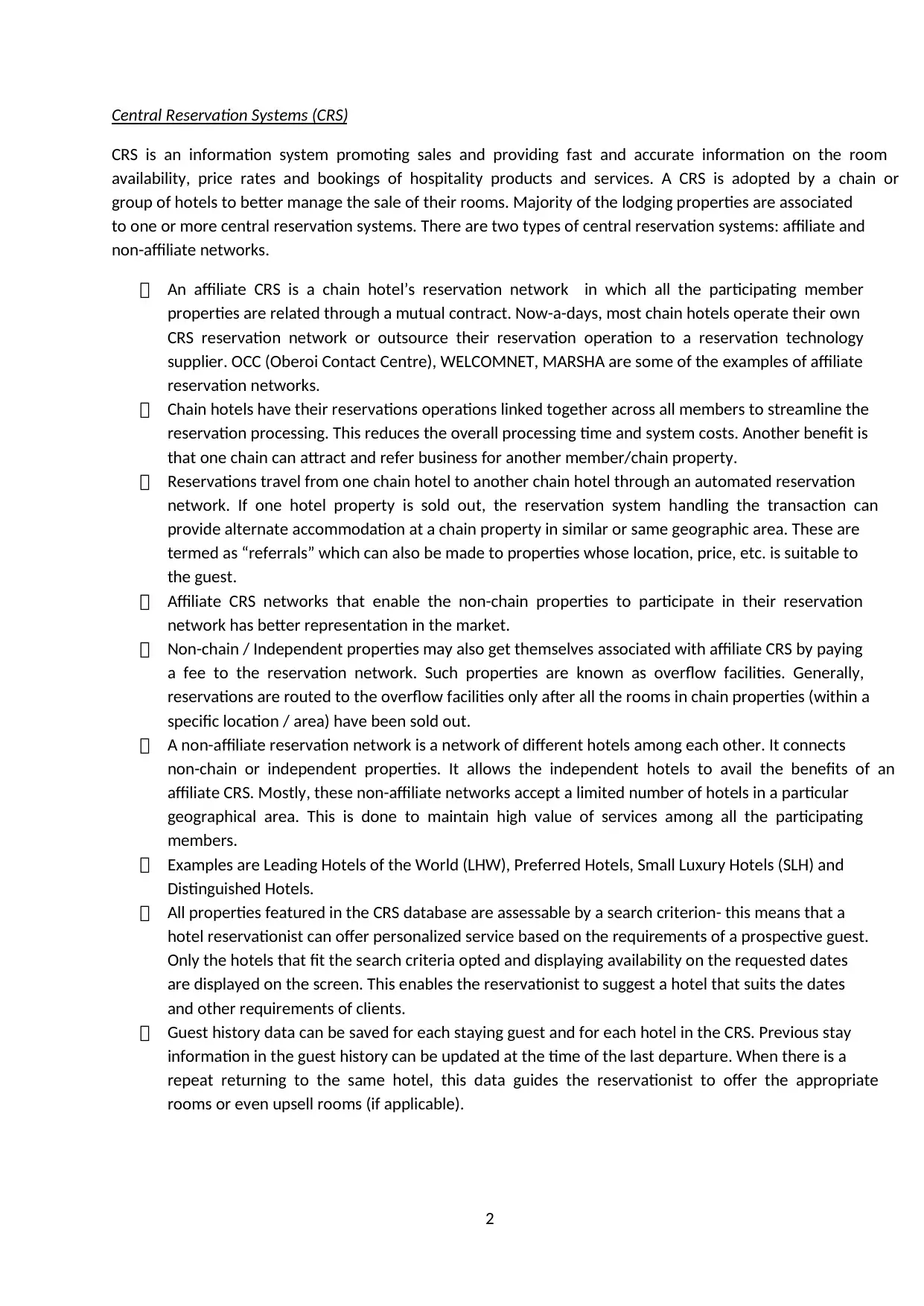
2
Central Reservation Systems (CRS)
CRS is an information system promoting sales and providing fast and accurate information on the room
availability, price rates and bookings of hospitality products and services. A CRS is adopted by a chain or
group of hotels to better manage the sale of their rooms. Majority of the lodging properties are associated
to one or more central reservation systems. There are two types of central reservation systems: affiliate and
non-affiliate networks.
An affiliate CRS is a chain hotel’s reservation network in which all the participating member
properties are related through a mutual contract. Now-a-days, most chain hotels operate their own
CRS reservation network or outsource their reservation operation to a reservation technology
supplier. OCC (Oberoi Contact Centre), WELCOMNET, MARSHA are some of the examples of affiliate
reservation networks.
Chain hotels have their reservations operations linked together across all members to streamline the
reservation processing. This reduces the overall processing time and system costs. Another benefit is
that one chain can attract and refer business for another member/chain property.
Reservations travel from one chain hotel to another chain hotel through an automated reservation
network. If one hotel property is sold out, the reservation system handling the transaction can
provide alternate accommodation at a chain property in similar or same geographic area. These are
termed as “referrals” which can also be made to properties whose location, price, etc. is suitable to
the guest.
Affiliate CRS networks that enable the non-chain properties to participate in their reservation
network has better representation in the market.
Non-chain / Independent properties may also get themselves associated with affiliate CRS by paying
a fee to the reservation network. Such properties are known as overflow facilities. Generally,
reservations are routed to the overflow facilities only after all the rooms in chain properties (within a
specific location / area) have been sold out.
A non-affiliate reservation network is a network of different hotels among each other. It connects
non-chain or independent properties. It allows the independent hotels to avail the benefits of an
affiliate CRS. Mostly, these non-affiliate networks accept a limited number of hotels in a particular
geographical area. This is done to maintain high value of services among all the participating
members.
Examples are Leading Hotels of the World (LHW), Preferred Hotels, Small Luxury Hotels (SLH) and
Distinguished Hotels.
All properties featured in the CRS database are assessable by a search criterion- this means that a
hotel reservationist can offer personalized service based on the requirements of a prospective guest.
Only the hotels that fit the search criteria opted and displaying availability on the requested dates
are displayed on the screen. This enables the reservationist to suggest a hotel that suits the dates
and other requirements of clients.
Guest history data can be saved for each staying guest and for each hotel in the CRS. Previous stay
information in the guest history can be updated at the time of the last departure. When there is a
repeat returning to the same hotel, this data guides the reservationist to offer the appropriate
rooms or even upsell rooms (if applicable).
Central Reservation Systems (CRS)
CRS is an information system promoting sales and providing fast and accurate information on the room
availability, price rates and bookings of hospitality products and services. A CRS is adopted by a chain or
group of hotels to better manage the sale of their rooms. Majority of the lodging properties are associated
to one or more central reservation systems. There are two types of central reservation systems: affiliate and
non-affiliate networks.
An affiliate CRS is a chain hotel’s reservation network in which all the participating member
properties are related through a mutual contract. Now-a-days, most chain hotels operate their own
CRS reservation network or outsource their reservation operation to a reservation technology
supplier. OCC (Oberoi Contact Centre), WELCOMNET, MARSHA are some of the examples of affiliate
reservation networks.
Chain hotels have their reservations operations linked together across all members to streamline the
reservation processing. This reduces the overall processing time and system costs. Another benefit is
that one chain can attract and refer business for another member/chain property.
Reservations travel from one chain hotel to another chain hotel through an automated reservation
network. If one hotel property is sold out, the reservation system handling the transaction can
provide alternate accommodation at a chain property in similar or same geographic area. These are
termed as “referrals” which can also be made to properties whose location, price, etc. is suitable to
the guest.
Affiliate CRS networks that enable the non-chain properties to participate in their reservation
network has better representation in the market.
Non-chain / Independent properties may also get themselves associated with affiliate CRS by paying
a fee to the reservation network. Such properties are known as overflow facilities. Generally,
reservations are routed to the overflow facilities only after all the rooms in chain properties (within a
specific location / area) have been sold out.
A non-affiliate reservation network is a network of different hotels among each other. It connects
non-chain or independent properties. It allows the independent hotels to avail the benefits of an
affiliate CRS. Mostly, these non-affiliate networks accept a limited number of hotels in a particular
geographical area. This is done to maintain high value of services among all the participating
members.
Examples are Leading Hotels of the World (LHW), Preferred Hotels, Small Luxury Hotels (SLH) and
Distinguished Hotels.
All properties featured in the CRS database are assessable by a search criterion- this means that a
hotel reservationist can offer personalized service based on the requirements of a prospective guest.
Only the hotels that fit the search criteria opted and displaying availability on the requested dates
are displayed on the screen. This enables the reservationist to suggest a hotel that suits the dates
and other requirements of clients.
Guest history data can be saved for each staying guest and for each hotel in the CRS. Previous stay
information in the guest history can be updated at the time of the last departure. When there is a
repeat returning to the same hotel, this data guides the reservationist to offer the appropriate
rooms or even upsell rooms (if applicable).
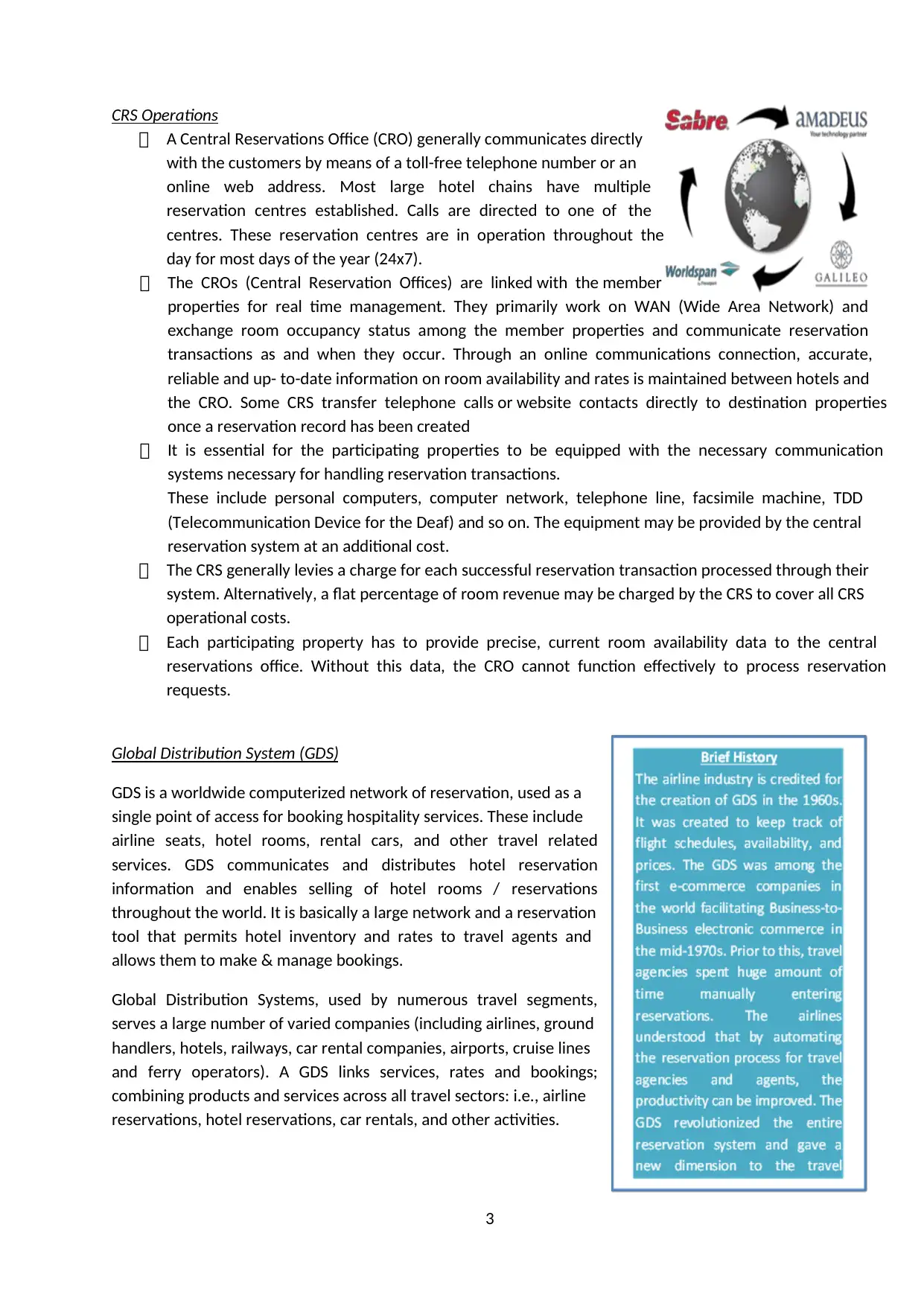
3
CRS Operations
A Central Reservations Office (CRO) generally communicates directly
with the customers by means of a toll-free telephone number or an
online web address. Most large hotel chains have multiple
reservation centres established. Calls are directed to one of the
centres. These reservation centres are in operation throughout the
day for most days of the year (24x7).
The CROs (Central Reservation Offices) are linked with the member
properties for real time management. They primarily work on WAN (Wide Area Network) and
exchange room occupancy status among the member properties and communicate reservation
transactions as and when they occur. Through an online communications connection, accurate,
reliable and up- to-date information on room availability and rates is maintained between hotels and
the CRO. Some CRS transfer telephone calls or website contacts directly to destination properties
once a reservation record has been created
It is essential for the participating properties to be equipped with the necessary communication
systems necessary for handling reservation transactions.
These include personal computers, computer network, telephone line, facsimile machine, TDD
(Telecommunication Device for the Deaf) and so on. The equipment may be provided by the central
reservation system at an additional cost.
The CRS generally levies a charge for each successful reservation transaction processed through their
system. Alternatively, a flat percentage of room revenue may be charged by the CRS to cover all CRS
operational costs.
Each participating property has to provide precise, current room availability data to the central
reservations office. Without this data, the CRO cannot function effectively to process reservation
requests.
Global Distribution System (GDS)
GDS is a worldwide computerized network of reservation, used as a
single point of access for booking hospitality services. These include
airline seats, hotel rooms, rental cars, and other travel related
services. GDS communicates and distributes hotel reservation
information and enables selling of hotel rooms / reservations
throughout the world. It is basically a large network and a reservation
tool that permits hotel inventory and rates to travel agents and
allows them to make & manage bookings.
Global Distribution Systems, used by numerous travel segments,
serves a large number of varied companies (including airlines, ground
handlers, hotels, railways, car rental companies, airports, cruise lines
and ferry operators). A GDS links services, rates and bookings;
combining products and services across all travel sectors: i.e., airline
reservations, hotel reservations, car rentals, and other activities.
CRS Operations
A Central Reservations Office (CRO) generally communicates directly
with the customers by means of a toll-free telephone number or an
online web address. Most large hotel chains have multiple
reservation centres established. Calls are directed to one of the
centres. These reservation centres are in operation throughout the
day for most days of the year (24x7).
The CROs (Central Reservation Offices) are linked with the member
properties for real time management. They primarily work on WAN (Wide Area Network) and
exchange room occupancy status among the member properties and communicate reservation
transactions as and when they occur. Through an online communications connection, accurate,
reliable and up- to-date information on room availability and rates is maintained between hotels and
the CRO. Some CRS transfer telephone calls or website contacts directly to destination properties
once a reservation record has been created
It is essential for the participating properties to be equipped with the necessary communication
systems necessary for handling reservation transactions.
These include personal computers, computer network, telephone line, facsimile machine, TDD
(Telecommunication Device for the Deaf) and so on. The equipment may be provided by the central
reservation system at an additional cost.
The CRS generally levies a charge for each successful reservation transaction processed through their
system. Alternatively, a flat percentage of room revenue may be charged by the CRS to cover all CRS
operational costs.
Each participating property has to provide precise, current room availability data to the central
reservations office. Without this data, the CRO cannot function effectively to process reservation
requests.
Global Distribution System (GDS)
GDS is a worldwide computerized network of reservation, used as a
single point of access for booking hospitality services. These include
airline seats, hotel rooms, rental cars, and other travel related
services. GDS communicates and distributes hotel reservation
information and enables selling of hotel rooms / reservations
throughout the world. It is basically a large network and a reservation
tool that permits hotel inventory and rates to travel agents and
allows them to make & manage bookings.
Global Distribution Systems, used by numerous travel segments,
serves a large number of varied companies (including airlines, ground
handlers, hotels, railways, car rental companies, airports, cruise lines
and ferry operators). A GDS links services, rates and bookings;
combining products and services across all travel sectors: i.e., airline
reservations, hotel reservations, car rentals, and other activities.
⊘ This is a preview!⊘
Do you want full access?
Subscribe today to unlock all pages.

Trusted by 1+ million students worldwide
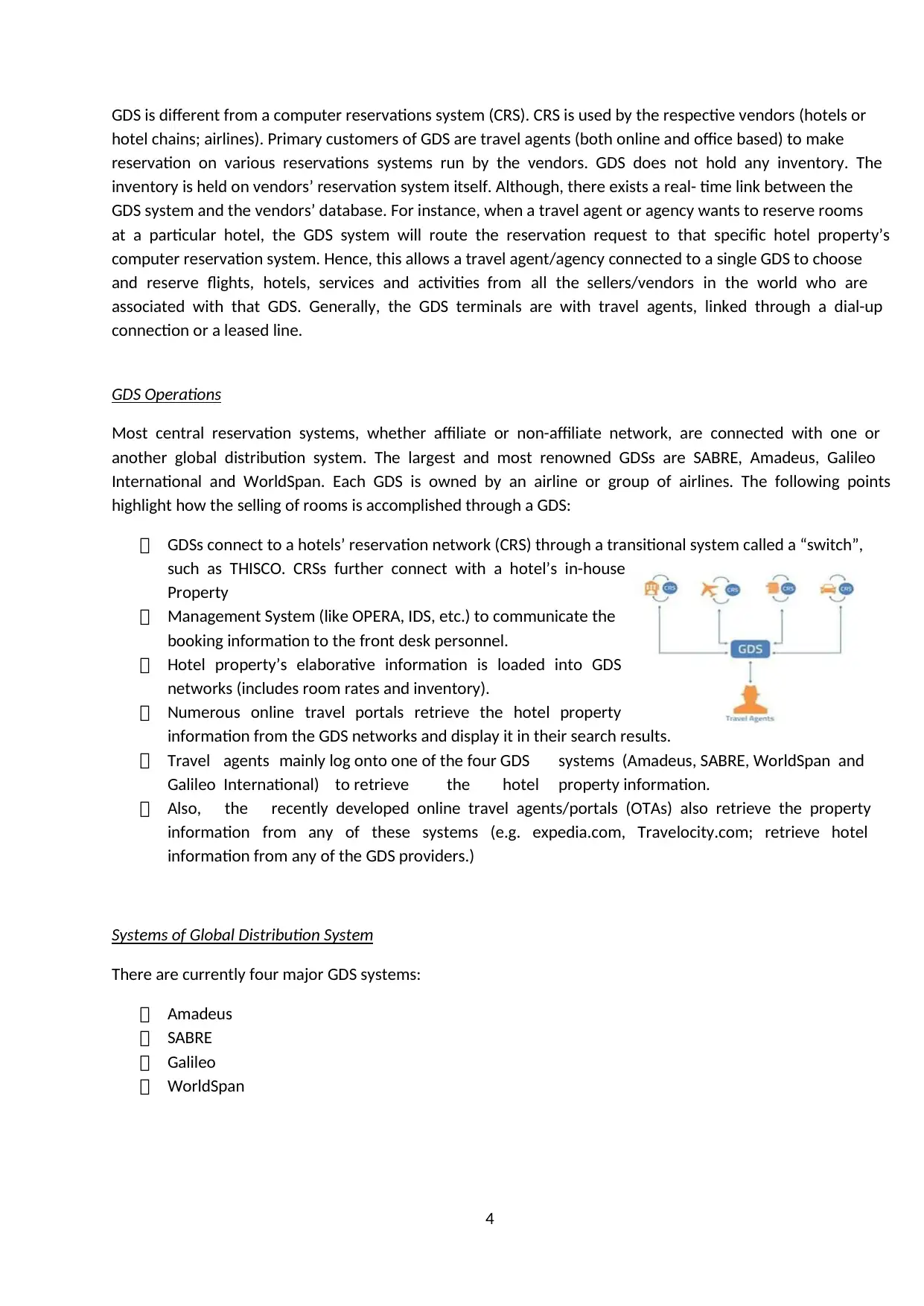
4
GDS is different from a computer reservations system (CRS). CRS is used by the respective vendors (hotels or
hotel chains; airlines). Primary customers of GDS are travel agents (both online and office based) to make
reservation on various reservations systems run by the vendors. GDS does not hold any inventory. The
inventory is held on vendors’ reservation system itself. Although, there exists a real- time link between the
GDS system and the vendors’ database. For instance, when a travel agent or agency wants to reserve rooms
at a particular hotel, the GDS system will route the reservation request to that specific hotel property’s
computer reservation system. Hence, this allows a travel agent/agency connected to a single GDS to choose
and reserve flights, hotels, services and activities from all the sellers/vendors in the world who are
associated with that GDS. Generally, the GDS terminals are with travel agents, linked through a dial-up
connection or a leased line.
GDS Operations
Most central reservation systems, whether affiliate or non-affiliate network, are connected with one or
another global distribution system. The largest and most renowned GDSs are SABRE, Amadeus, Galileo
International and WorldSpan. Each GDS is owned by an airline or group of airlines. The following points
highlight how the selling of rooms is accomplished through a GDS:
GDSs connect to a hotels’ reservation network (CRS) through a transitional system called a “switch”,
such as THISCO. CRSs further connect with a hotel’s in-house
Property
Management System (like OPERA, IDS, etc.) to communicate the
booking information to the front desk personnel.
Hotel property’s elaborative information is loaded into GDS
networks (includes room rates and inventory).
Numerous online travel portals retrieve the hotel property
information from the GDS networks and display it in their search results.
Travel agents mainly log onto one of the four GDS systems (Amadeus, SABRE, WorldSpan and
Galileo International) to retrieve the hotel property information.
Also, the recently developed online travel agents/portals (OTAs) also retrieve the property
information from any of these systems (e.g. expedia.com, Travelocity.com; retrieve hotel
information from any of the GDS providers.)
Systems of Global Distribution System
There are currently four major GDS systems:
Amadeus
SABRE
Galileo
WorldSpan
GDS is different from a computer reservations system (CRS). CRS is used by the respective vendors (hotels or
hotel chains; airlines). Primary customers of GDS are travel agents (both online and office based) to make
reservation on various reservations systems run by the vendors. GDS does not hold any inventory. The
inventory is held on vendors’ reservation system itself. Although, there exists a real- time link between the
GDS system and the vendors’ database. For instance, when a travel agent or agency wants to reserve rooms
at a particular hotel, the GDS system will route the reservation request to that specific hotel property’s
computer reservation system. Hence, this allows a travel agent/agency connected to a single GDS to choose
and reserve flights, hotels, services and activities from all the sellers/vendors in the world who are
associated with that GDS. Generally, the GDS terminals are with travel agents, linked through a dial-up
connection or a leased line.
GDS Operations
Most central reservation systems, whether affiliate or non-affiliate network, are connected with one or
another global distribution system. The largest and most renowned GDSs are SABRE, Amadeus, Galileo
International and WorldSpan. Each GDS is owned by an airline or group of airlines. The following points
highlight how the selling of rooms is accomplished through a GDS:
GDSs connect to a hotels’ reservation network (CRS) through a transitional system called a “switch”,
such as THISCO. CRSs further connect with a hotel’s in-house
Property
Management System (like OPERA, IDS, etc.) to communicate the
booking information to the front desk personnel.
Hotel property’s elaborative information is loaded into GDS
networks (includes room rates and inventory).
Numerous online travel portals retrieve the hotel property
information from the GDS networks and display it in their search results.
Travel agents mainly log onto one of the four GDS systems (Amadeus, SABRE, WorldSpan and
Galileo International) to retrieve the hotel property information.
Also, the recently developed online travel agents/portals (OTAs) also retrieve the property
information from any of these systems (e.g. expedia.com, Travelocity.com; retrieve hotel
information from any of the GDS providers.)
Systems of Global Distribution System
There are currently four major GDS systems:
Amadeus
SABRE
Galileo
WorldSpan
Paraphrase This Document
Need a fresh take? Get an instant paraphrase of this document with our AI Paraphraser
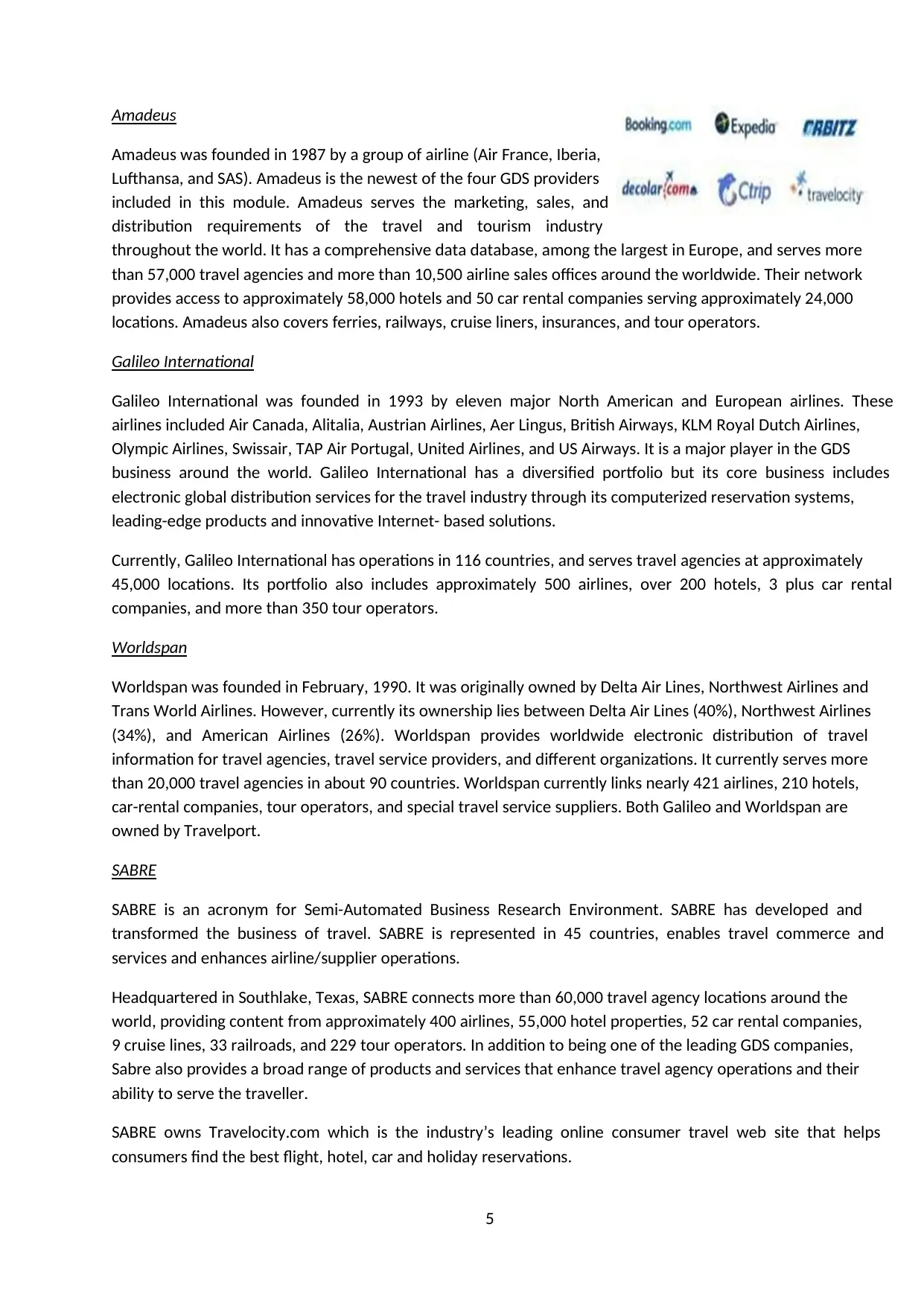
5
Amadeus
Amadeus was founded in 1987 by a group of airline (Air France, Iberia,
Lufthansa, and SAS). Amadeus is the newest of the four GDS providers
included in this module. Amadeus serves the marketing, sales, and
distribution requirements of the travel and tourism industry
throughout the world. It has a comprehensive data database, among the largest in Europe, and serves more
than 57,000 travel agencies and more than 10,500 airline sales offices around the worldwide. Their network
provides access to approximately 58,000 hotels and 50 car rental companies serving approximately 24,000
locations. Amadeus also covers ferries, railways, cruise liners, insurances, and tour operators.
Galileo International
Galileo International was founded in 1993 by eleven major North American and European airlines. These
airlines included Air Canada, Alitalia, Austrian Airlines, Aer Lingus, British Airways, KLM Royal Dutch Airlines,
Olympic Airlines, Swissair, TAP Air Portugal, United Airlines, and US Airways. It is a major player in the GDS
business around the world. Galileo International has a diversified portfolio but its core business includes
electronic global distribution services for the travel industry through its computerized reservation systems,
leading-edge products and innovative Internet- based solutions.
Currently, Galileo International has operations in 116 countries, and serves travel agencies at approximately
45,000 locations. Its portfolio also includes approximately 500 airlines, over 200 hotels, 3 plus car rental
companies, and more than 350 tour operators.
Worldspan
Worldspan was founded in February, 1990. It was originally owned by Delta Air Lines, Northwest Airlines and
Trans World Airlines. However, currently its ownership lies between Delta Air Lines (40%), Northwest Airlines
(34%), and American Airlines (26%). Worldspan provides worldwide electronic distribution of travel
information for travel agencies, travel service providers, and different organizations. It currently serves more
than 20,000 travel agencies in about 90 countries. Worldspan currently links nearly 421 airlines, 210 hotels,
car-rental companies, tour operators, and special travel service suppliers. Both Galileo and Worldspan are
owned by Travelport.
SABRE
SABRE is an acronym for Semi-Automated Business Research Environment. SABRE has developed and
transformed the business of travel. SABRE is represented in 45 countries, enables travel commerce and
services and enhances airline/supplier operations.
Headquartered in Southlake, Texas, SABRE connects more than 60,000 travel agency locations around the
world, providing content from approximately 400 airlines, 55,000 hotel properties, 52 car rental companies,
9 cruise lines, 33 railroads, and 229 tour operators. In addition to being one of the leading GDS companies,
Sabre also provides a broad range of products and services that enhance travel agency operations and their
ability to serve the traveller.
SABRE owns Travelocity.com which is the industry’s leading online consumer travel web site that helps
consumers find the best flight, hotel, car and holiday reservations.
Amadeus
Amadeus was founded in 1987 by a group of airline (Air France, Iberia,
Lufthansa, and SAS). Amadeus is the newest of the four GDS providers
included in this module. Amadeus serves the marketing, sales, and
distribution requirements of the travel and tourism industry
throughout the world. It has a comprehensive data database, among the largest in Europe, and serves more
than 57,000 travel agencies and more than 10,500 airline sales offices around the worldwide. Their network
provides access to approximately 58,000 hotels and 50 car rental companies serving approximately 24,000
locations. Amadeus also covers ferries, railways, cruise liners, insurances, and tour operators.
Galileo International
Galileo International was founded in 1993 by eleven major North American and European airlines. These
airlines included Air Canada, Alitalia, Austrian Airlines, Aer Lingus, British Airways, KLM Royal Dutch Airlines,
Olympic Airlines, Swissair, TAP Air Portugal, United Airlines, and US Airways. It is a major player in the GDS
business around the world. Galileo International has a diversified portfolio but its core business includes
electronic global distribution services for the travel industry through its computerized reservation systems,
leading-edge products and innovative Internet- based solutions.
Currently, Galileo International has operations in 116 countries, and serves travel agencies at approximately
45,000 locations. Its portfolio also includes approximately 500 airlines, over 200 hotels, 3 plus car rental
companies, and more than 350 tour operators.
Worldspan
Worldspan was founded in February, 1990. It was originally owned by Delta Air Lines, Northwest Airlines and
Trans World Airlines. However, currently its ownership lies between Delta Air Lines (40%), Northwest Airlines
(34%), and American Airlines (26%). Worldspan provides worldwide electronic distribution of travel
information for travel agencies, travel service providers, and different organizations. It currently serves more
than 20,000 travel agencies in about 90 countries. Worldspan currently links nearly 421 airlines, 210 hotels,
car-rental companies, tour operators, and special travel service suppliers. Both Galileo and Worldspan are
owned by Travelport.
SABRE
SABRE is an acronym for Semi-Automated Business Research Environment. SABRE has developed and
transformed the business of travel. SABRE is represented in 45 countries, enables travel commerce and
services and enhances airline/supplier operations.
Headquartered in Southlake, Texas, SABRE connects more than 60,000 travel agency locations around the
world, providing content from approximately 400 airlines, 55,000 hotel properties, 52 car rental companies,
9 cruise lines, 33 railroads, and 229 tour operators. In addition to being one of the leading GDS companies,
Sabre also provides a broad range of products and services that enhance travel agency operations and their
ability to serve the traveller.
SABRE owns Travelocity.com which is the industry’s leading online consumer travel web site that helps
consumers find the best flight, hotel, car and holiday reservations.
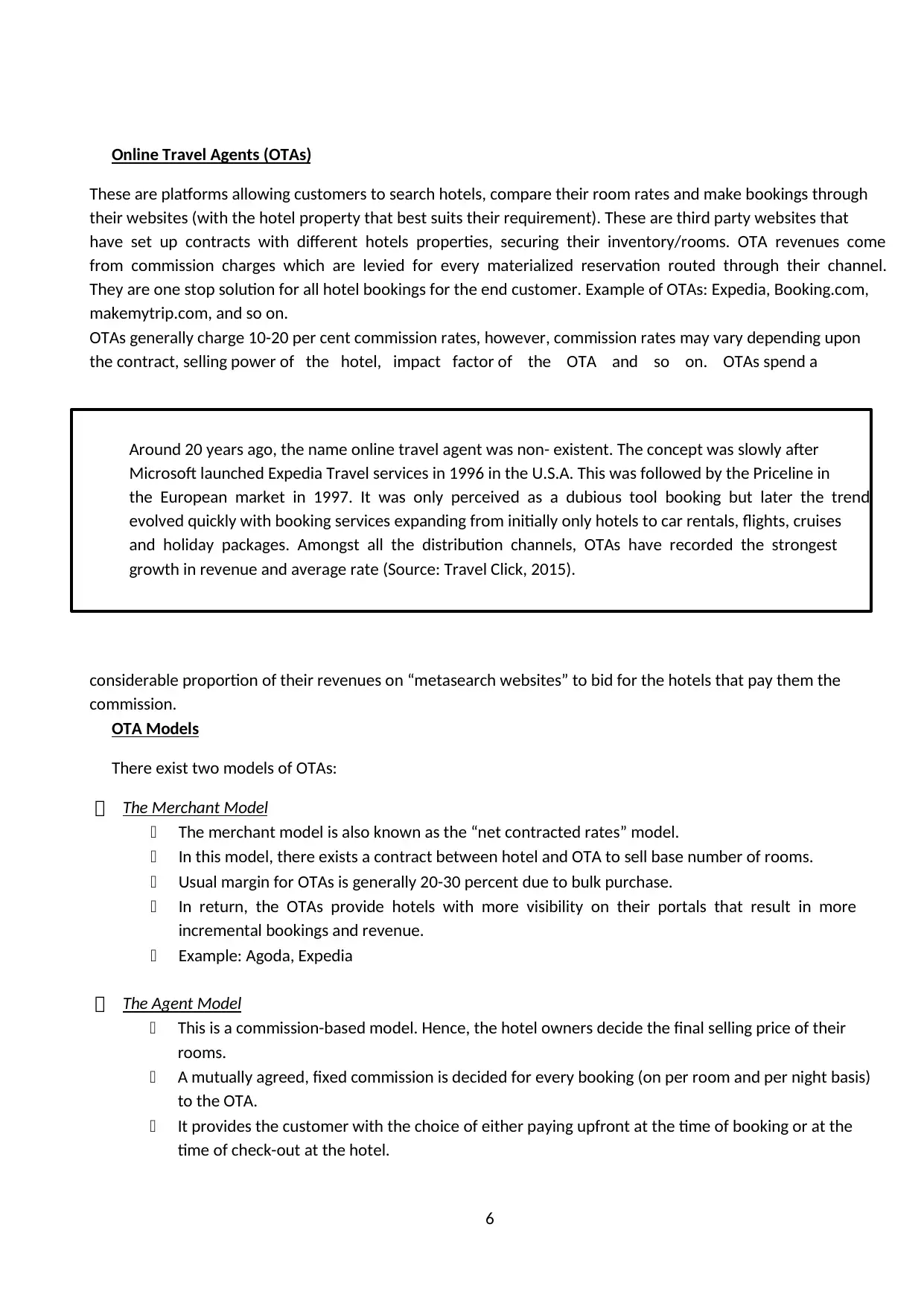
6
Online Travel Agents (OTAs)
These are platforms allowing customers to search hotels, compare their room rates and make bookings through
their websites (with the hotel property that best suits their requirement). These are third party websites that
have set up contracts with different hotels properties, securing their inventory/rooms. OTA revenues come
from commission charges which are levied for every materialized reservation routed through their channel.
They are one stop solution for all hotel bookings for the end customer. Example of OTAs: Expedia, Booking.com,
makemytrip.com, and so on.
OTAs generally charge 10-20 per cent commission rates, however, commission rates may vary depending upon
the contract, selling power of the hotel, impact factor of the OTA and so on. OTAs spend a
considerable proportion of their revenues on “metasearch websites” to bid for the hotels that pay them the
commission.
OTA Models
There exist two models of OTAs:
The Merchant Model
The merchant model is also known as the “net contracted rates” model.
In this model, there exists a contract between hotel and OTA to sell base number of rooms.
Usual margin for OTAs is generally 20-30 percent due to bulk purchase.
In return, the OTAs provide hotels with more visibility on their portals that result in more
incremental bookings and revenue.
Example: Agoda, Expedia
The Agent Model
This is a commission-based model. Hence, the hotel owners decide the final selling price of their
rooms.
A mutually agreed, fixed commission is decided for every booking (on per room and per night basis)
to the OTA.
It provides the customer with the choice of either paying upfront at the time of booking or at the
time of check-out at the hotel.
Around 20 years ago, the name online travel agent was non- existent. The concept was slowly after
Microsoft launched Expedia Travel services in 1996 in the U.S.A. This was followed by the Priceline in
the European market in 1997. It was only perceived as a dubious tool booking but later the trend
evolved quickly with booking services expanding from initially only hotels to car rentals, flights, cruises
and holiday packages. Amongst all the distribution channels, OTAs have recorded the strongest
growth in revenue and average rate (Source: Travel Click, 2015).
Online Travel Agents (OTAs)
These are platforms allowing customers to search hotels, compare their room rates and make bookings through
their websites (with the hotel property that best suits their requirement). These are third party websites that
have set up contracts with different hotels properties, securing their inventory/rooms. OTA revenues come
from commission charges which are levied for every materialized reservation routed through their channel.
They are one stop solution for all hotel bookings for the end customer. Example of OTAs: Expedia, Booking.com,
makemytrip.com, and so on.
OTAs generally charge 10-20 per cent commission rates, however, commission rates may vary depending upon
the contract, selling power of the hotel, impact factor of the OTA and so on. OTAs spend a
considerable proportion of their revenues on “metasearch websites” to bid for the hotels that pay them the
commission.
OTA Models
There exist two models of OTAs:
The Merchant Model
The merchant model is also known as the “net contracted rates” model.
In this model, there exists a contract between hotel and OTA to sell base number of rooms.
Usual margin for OTAs is generally 20-30 percent due to bulk purchase.
In return, the OTAs provide hotels with more visibility on their portals that result in more
incremental bookings and revenue.
Example: Agoda, Expedia
The Agent Model
This is a commission-based model. Hence, the hotel owners decide the final selling price of their
rooms.
A mutually agreed, fixed commission is decided for every booking (on per room and per night basis)
to the OTA.
It provides the customer with the choice of either paying upfront at the time of booking or at the
time of check-out at the hotel.
Around 20 years ago, the name online travel agent was non- existent. The concept was slowly after
Microsoft launched Expedia Travel services in 1996 in the U.S.A. This was followed by the Priceline in
the European market in 1997. It was only perceived as a dubious tool booking but later the trend
evolved quickly with booking services expanding from initially only hotels to car rentals, flights, cruises
and holiday packages. Amongst all the distribution channels, OTAs have recorded the strongest
growth in revenue and average rate (Source: Travel Click, 2015).
⊘ This is a preview!⊘
Do you want full access?
Subscribe today to unlock all pages.

Trusted by 1+ million students worldwide
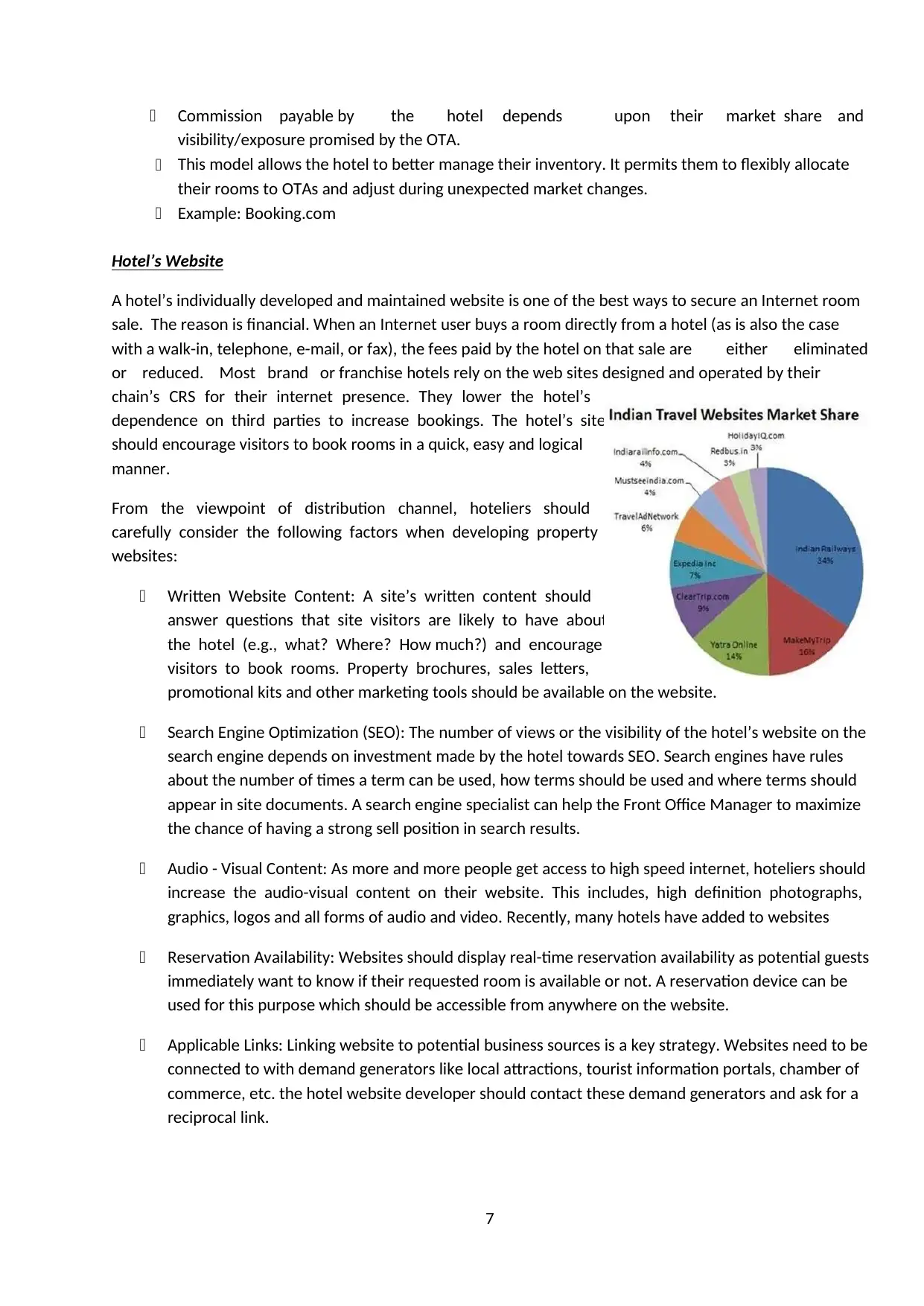
7
Commission payable by the hotel depends upon their market share and
visibility/exposure promised by the OTA.
This model allows the hotel to better manage their inventory. It permits them to flexibly allocate
their rooms to OTAs and adjust during unexpected market changes.
Example: Booking.com
Hotel’s Website
A hotel’s individually developed and maintained website is one of the best ways to secure an Internet room
sale. The reason is financial. When an Internet user buys a room directly from a hotel (as is also the case
with a walk-in, telephone, e-mail, or fax), the fees paid by the hotel on that sale are either eliminated
or reduced. Most brand or franchise hotels rely on the web sites designed and operated by their
chain’s CRS for their internet presence. They lower the hotel’s
dependence on third parties to increase bookings. The hotel’s site
should encourage visitors to book rooms in a quick, easy and logical
manner.
From the viewpoint of distribution channel, hoteliers should
carefully consider the following factors when developing property
websites:
Written Website Content: A site’s written content should
answer questions that site visitors are likely to have about
the hotel (e.g., what? Where? How much?) and encourage
visitors to book rooms. Property brochures, sales letters,
promotional kits and other marketing tools should be available on the website.
Search Engine Optimization (SEO): The number of views or the visibility of the hotel’s website on the
search engine depends on investment made by the hotel towards SEO. Search engines have rules
about the number of times a term can be used, how terms should be used and where terms should
appear in site documents. A search engine specialist can help the Front Office Manager to maximize
the chance of having a strong sell position in search results.
Audio - Visual Content: As more and more people get access to high speed internet, hoteliers should
increase the audio-visual content on their website. This includes, high definition photographs,
graphics, logos and all forms of audio and video. Recently, many hotels have added to websites
Reservation Availability: Websites should display real-time reservation availability as potential guests
immediately want to know if their requested room is available or not. A reservation device can be
used for this purpose which should be accessible from anywhere on the website.
Applicable Links: Linking website to potential business sources is a key strategy. Websites need to be
connected to with demand generators like local attractions, tourist information portals, chamber of
commerce, etc. the hotel website developer should contact these demand generators and ask for a
reciprocal link.
Commission payable by the hotel depends upon their market share and
visibility/exposure promised by the OTA.
This model allows the hotel to better manage their inventory. It permits them to flexibly allocate
their rooms to OTAs and adjust during unexpected market changes.
Example: Booking.com
Hotel’s Website
A hotel’s individually developed and maintained website is one of the best ways to secure an Internet room
sale. The reason is financial. When an Internet user buys a room directly from a hotel (as is also the case
with a walk-in, telephone, e-mail, or fax), the fees paid by the hotel on that sale are either eliminated
or reduced. Most brand or franchise hotels rely on the web sites designed and operated by their
chain’s CRS for their internet presence. They lower the hotel’s
dependence on third parties to increase bookings. The hotel’s site
should encourage visitors to book rooms in a quick, easy and logical
manner.
From the viewpoint of distribution channel, hoteliers should
carefully consider the following factors when developing property
websites:
Written Website Content: A site’s written content should
answer questions that site visitors are likely to have about
the hotel (e.g., what? Where? How much?) and encourage
visitors to book rooms. Property brochures, sales letters,
promotional kits and other marketing tools should be available on the website.
Search Engine Optimization (SEO): The number of views or the visibility of the hotel’s website on the
search engine depends on investment made by the hotel towards SEO. Search engines have rules
about the number of times a term can be used, how terms should be used and where terms should
appear in site documents. A search engine specialist can help the Front Office Manager to maximize
the chance of having a strong sell position in search results.
Audio - Visual Content: As more and more people get access to high speed internet, hoteliers should
increase the audio-visual content on their website. This includes, high definition photographs,
graphics, logos and all forms of audio and video. Recently, many hotels have added to websites
Reservation Availability: Websites should display real-time reservation availability as potential guests
immediately want to know if their requested room is available or not. A reservation device can be
used for this purpose which should be accessible from anywhere on the website.
Applicable Links: Linking website to potential business sources is a key strategy. Websites need to be
connected to with demand generators like local attractions, tourist information portals, chamber of
commerce, etc. the hotel website developer should contact these demand generators and ask for a
reciprocal link.
Paraphrase This Document
Need a fresh take? Get an instant paraphrase of this document with our AI Paraphraser
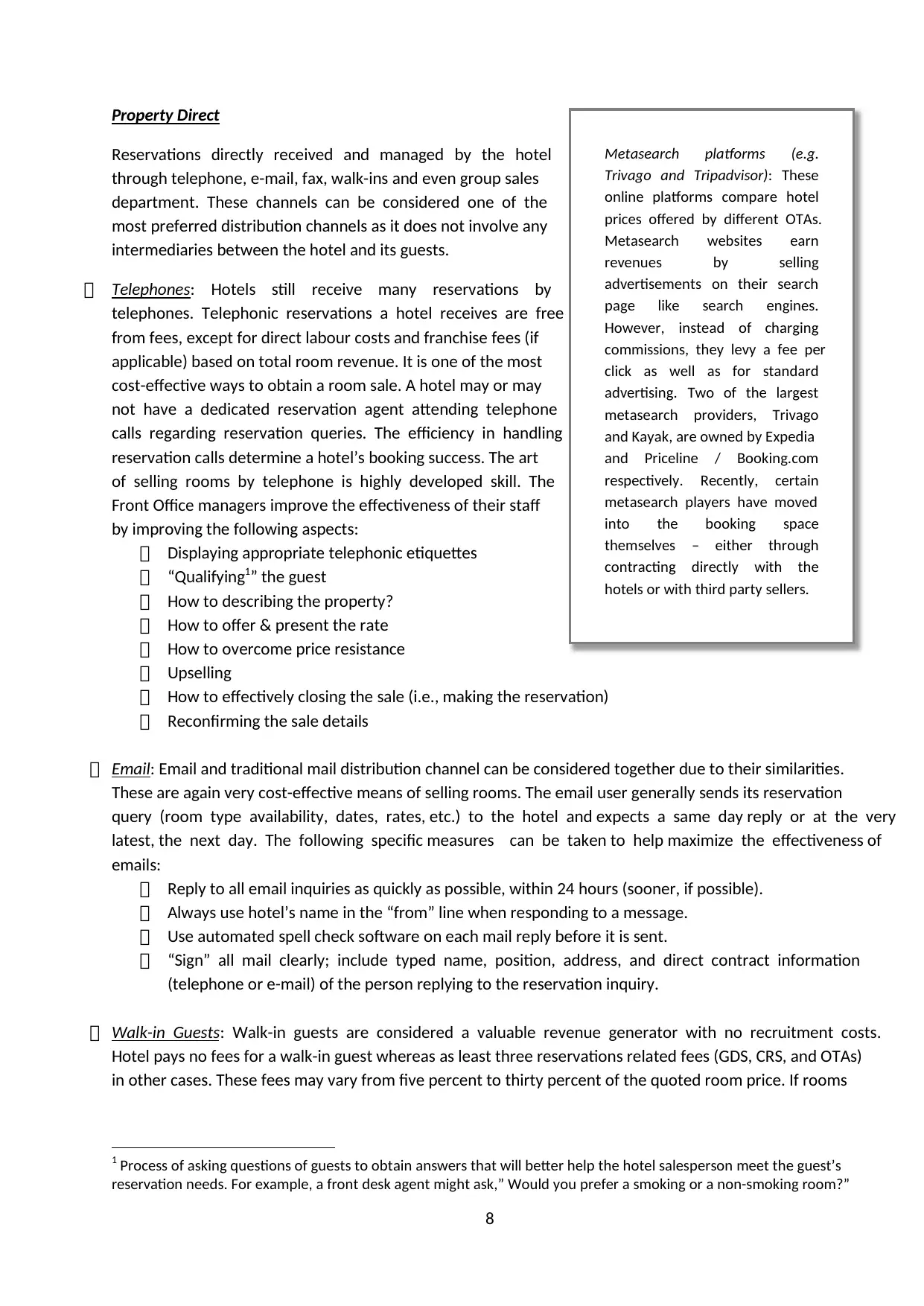
8
Property Direct
Reservations directly received and managed by the hotel
through telephone, e-mail, fax, walk-ins and even group sales
department. These channels can be considered one of the
most preferred distribution channels as it does not involve any
intermediaries between the hotel and its guests.
Telephones: Hotels still receive many reservations by
telephones. Telephonic reservations a hotel receives are free
from fees, except for direct labour costs and franchise fees (if
applicable) based on total room revenue. It is one of the most
cost-effective ways to obtain a room sale. A hotel may or may
not have a dedicated reservation agent attending telephone
calls regarding reservation queries. The efficiency in handling
reservation calls determine a hotel’s booking success. The art
of selling rooms by telephone is highly developed skill. The
Front Office managers improve the effectiveness of their staff
by improving the following aspects:
Displaying appropriate telephonic etiquettes
“Qualifying1” the guest
How to describing the property?
How to offer & present the rate
How to overcome price resistance
Upselling
How to effectively closing the sale (i.e., making the reservation)
Reconfirming the sale details
Email: Email and traditional mail distribution channel can be considered together due to their similarities.
These are again very cost-effective means of selling rooms. The email user generally sends its reservation
query (room type availability, dates, rates, etc.) to the hotel and expects a same day reply or at the very
latest, the next day. The following specific measures can be taken to help maximize the effectiveness of
emails:
Reply to all email inquiries as quickly as possible, within 24 hours (sooner, if possible).
Always use hotel’s name in the “from” line when responding to a message.
Use automated spell check software on each mail reply before it is sent.
“Sign” all mail clearly; include typed name, position, address, and direct contract information
(telephone or e-mail) of the person replying to the reservation inquiry.
Walk-in Guests: Walk-in guests are considered a valuable revenue generator with no recruitment costs.
Hotel pays no fees for a walk-in guest whereas as least three reservations related fees (GDS, CRS, and OTAs)
in other cases. These fees may vary from five percent to thirty percent of the quoted room price. If rooms
1 Process of asking questions of guests to obtain answers that will better help the hotel salesperson meet the guest’s
reservation needs. For example, a front desk agent might ask,” Would you prefer a smoking or a non-smoking room?”
Metasearch platforms (e.g.
Trivago and Tripadvisor): These
online platforms compare hotel
prices offered by different OTAs.
Metasearch websites earn
revenues by selling
advertisements on their search
page like search engines.
However, instead of charging
commissions, they levy a fee per
click as well as for standard
advertising. Two of the largest
metasearch providers, Trivago
and Kayak, are owned by Expedia
and Priceline / Booking.com
respectively. Recently, certain
metasearch players have moved
into the booking space
themselves – either through
contracting directly with the
hotels or with third party sellers.
Property Direct
Reservations directly received and managed by the hotel
through telephone, e-mail, fax, walk-ins and even group sales
department. These channels can be considered one of the
most preferred distribution channels as it does not involve any
intermediaries between the hotel and its guests.
Telephones: Hotels still receive many reservations by
telephones. Telephonic reservations a hotel receives are free
from fees, except for direct labour costs and franchise fees (if
applicable) based on total room revenue. It is one of the most
cost-effective ways to obtain a room sale. A hotel may or may
not have a dedicated reservation agent attending telephone
calls regarding reservation queries. The efficiency in handling
reservation calls determine a hotel’s booking success. The art
of selling rooms by telephone is highly developed skill. The
Front Office managers improve the effectiveness of their staff
by improving the following aspects:
Displaying appropriate telephonic etiquettes
“Qualifying1” the guest
How to describing the property?
How to offer & present the rate
How to overcome price resistance
Upselling
How to effectively closing the sale (i.e., making the reservation)
Reconfirming the sale details
Email: Email and traditional mail distribution channel can be considered together due to their similarities.
These are again very cost-effective means of selling rooms. The email user generally sends its reservation
query (room type availability, dates, rates, etc.) to the hotel and expects a same day reply or at the very
latest, the next day. The following specific measures can be taken to help maximize the effectiveness of
emails:
Reply to all email inquiries as quickly as possible, within 24 hours (sooner, if possible).
Always use hotel’s name in the “from” line when responding to a message.
Use automated spell check software on each mail reply before it is sent.
“Sign” all mail clearly; include typed name, position, address, and direct contract information
(telephone or e-mail) of the person replying to the reservation inquiry.
Walk-in Guests: Walk-in guests are considered a valuable revenue generator with no recruitment costs.
Hotel pays no fees for a walk-in guest whereas as least three reservations related fees (GDS, CRS, and OTAs)
in other cases. These fees may vary from five percent to thirty percent of the quoted room price. If rooms
1 Process of asking questions of guests to obtain answers that will better help the hotel salesperson meet the guest’s
reservation needs. For example, a front desk agent might ask,” Would you prefer a smoking or a non-smoking room?”
Metasearch platforms (e.g.
Trivago and Tripadvisor): These
online platforms compare hotel
prices offered by different OTAs.
Metasearch websites earn
revenues by selling
advertisements on their search
page like search engines.
However, instead of charging
commissions, they levy a fee per
click as well as for standard
advertising. Two of the largest
metasearch providers, Trivago
and Kayak, are owned by Expedia
and Priceline / Booking.com
respectively. Recently, certain
metasearch players have moved
into the booking space
themselves – either through
contracting directly with the
hotels or with third party sellers.
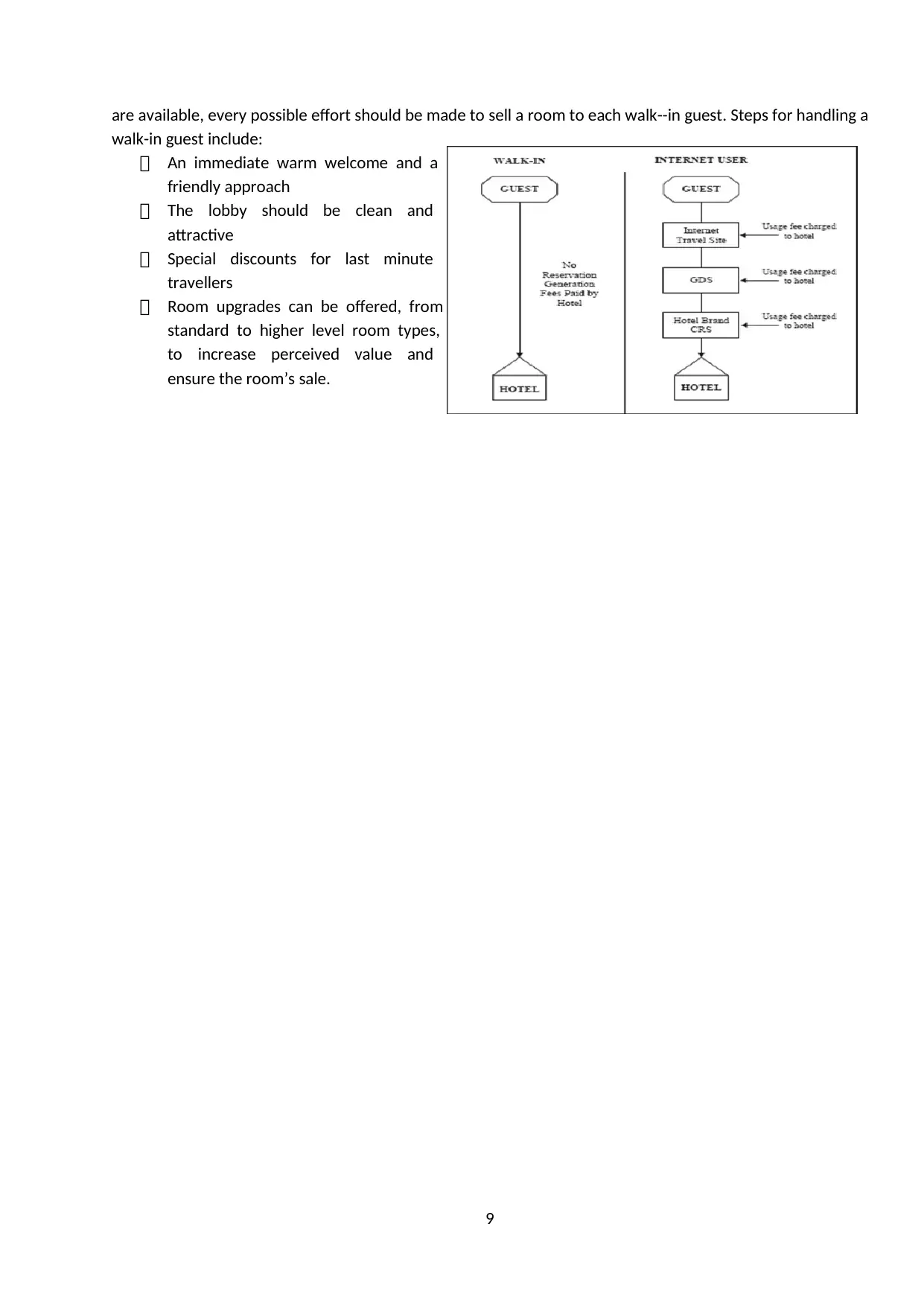
9
are available, every possible effort should be made to sell a room to each walk--in guest. Steps for handling a
walk-in guest include:
An immediate warm welcome and a
friendly approach
The lobby should be clean and
attractive
Special discounts for last minute
travellers
Room upgrades can be offered, from
standard to higher level room types,
to increase perceived value and
ensure the room’s sale.
are available, every possible effort should be made to sell a room to each walk--in guest. Steps for handling a
walk-in guest include:
An immediate warm welcome and a
friendly approach
The lobby should be clean and
attractive
Special discounts for last minute
travellers
Room upgrades can be offered, from
standard to higher level room types,
to increase perceived value and
ensure the room’s sale.
⊘ This is a preview!⊘
Do you want full access?
Subscribe today to unlock all pages.

Trusted by 1+ million students worldwide
1 out of 9
Related Documents
Your All-in-One AI-Powered Toolkit for Academic Success.
+13062052269
info@desklib.com
Available 24*7 on WhatsApp / Email
![[object Object]](/_next/static/media/star-bottom.7253800d.svg)
Unlock your academic potential
Copyright © 2020–2025 A2Z Services. All Rights Reserved. Developed and managed by ZUCOL.




